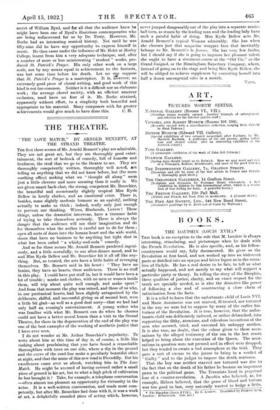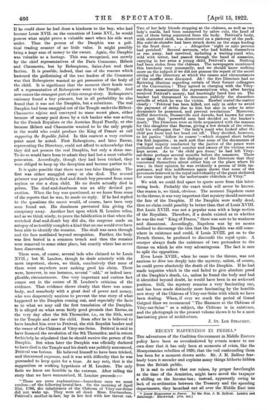13 0 0 K S .
THE DAUPHIN (LOUIS XNTI.).* This book is no exception to the rule that M. Len6tre is always interesting, stimulating, and picturesque when ho deals with the French Revolution. He is also specific, and, as his fellow- countrymen would say, fully documented. He gives us the Revolution at first hand, and not worked up into an iridescent paste or distilled into an opaque and bitter liquor as in the narra- tive of Carlyle. He has a real desire to be fair, to tell us what actually happened, and not merely to say what will support a particular party or theory. In telling the story of the Dauphin, these qualities of justice, clarity, and an exact respect for the truth are specially needed, as is also the detective-like power of following a clue and of constructing a close chain of ratiocination from the facts.
It is a relief to learn that the unfortunate child of Louis XVI. and Marie Antoinette was not starved, ill-treated, nor tortured in the way we were led to suppose by many of the earlier his- torians of the Revolution. It is true, however, that the unfor- tunate child was deliberately induced, or rather debauched, into supporting the filthy, atrocious, and ridiculous inventions of the men who accused, tried, and executed his unhappy mother. It is also true, no doubt, that the colour given to these accu- sations by the alleged testimony of the son in the last resort helped to bring about the execution of the Queen. The accu- sations in question were not pressed and in effect were dropped, but they tended to create a bad atmosphere at the trial. They gave a sort of excuse to the jurors to bring in a verdict of " Guilty " and to the judges to impose the death sentence. That the 'boy was neither starved nor tortured was due to the fact that on the death of his father he became an important pawn in the political game. The Terrorists lived in perpetual fear of a counter-revolution. A Jacobin who believed, as, for example, Hebert believed, that the game of blood and torture was too good to last, very naturally wanted to hedge a little.
• The Dauphin (Louis XVII.). By G. Len/nre. Translated by Frederic Lees, London : Heinemann. I15s. nct.1
If he could show he had done a kindness to the boy, who had become Louis XVII. on the execution of Louis XVI., he would possess what might prove a valuable asset when his side went under. Thus the person of the Dauphin was a poli- tical trading counter of no little value. It might possibly bring a huge sum of money to the owner. Again, the Dauphin was valuable as a hostage. This was recognized, not merely by the chief representatives of the Paris Commune, Hebert and Chaumette, but by Robespierre, Saint-Just and their faction. It is possible, indeed, that one of the reasons which hastened the guillotining of the two leaders of the Commune was that Robespierre wanted to get possession of the body of the. child. It is significant that the moment their heads were off a representative of Robespierre went to the Temple. And now comes the strangest part of this strange story. Robespierre's emissary found a boy prisoner, but in all probability he also
found that it was not the Dauphin, but a substitute. The real Dauphin had been smuggled out of the Temple under the Hebert- Chaumette regime and conveyed to some secret place, either
because of money paid down by a rich banker who was acting for the French Royalists or the Austrian Royal Family, or else
because Hebert and Chanmette wanted to be the only people in the world who could produce the King of France at call supposing the Republic failed. In this context a very curious point must be noted. First Robespierre, and later Barras, representing the Directory, could not afford to acknowledge that they did not possess the real Dauphin, but only a sham one. To do so would have been to admit they had lost a most valuable
possession. Accordingly, though they had been tricked, they were obliged to keep up the deception and become parties to it.
It is quite possible that there were two false Dauphins. The first was either smuggled away or else died. The second prisoner was probably a deaf-and-dumb boy procured from some asylum or else a slum child. He no doubt actually died in
prison. The deaf-and-dumbness was an ably devised' pre- caution. When the boy was questioned, as we know from some of the reports that he was, he made no reply. If he had replied to the questions the secret would, of course, have been very soon found out. His dumbness prevented him giving the conspiracy away. Another fact upon which M. LenOtre relies, and as we think wisely, to prove the falsification-is that when the wretched deaf-and-dumb boy did die, the surgeons made an autopsy of so terribljr complete a kind that no one would ever have been able to identify the remains. The skull was sawn through
and the face mutilated beyond recognition. Further, the body was first buried in a common trench and then the remains were removed to some other place, but exactly where has never been discovered.
There were, of course, several lads who claimed to be Louis ; but M. Len8tre, though he deals minutely with the most important, shows, we think, conclusively that none of them went anywhere near making good his claim. There were, however, in one instance, several " odd," or indeed inex- plicable, circumstances. One very important and curious fact comes out in the course of M. Lenotre's criticism of the evidence. That evidence shows clearly that there was some- body, and somebody with a great deal of power and money, who was desperately anxious to prevent the true story of what happened to the Dauphin coming out, and especially the facts
as to what we may call the first translation of the Dauphin. It is alleged on what seem fairly good grounds that Barras, on the very day after the 9th Thermidor, i.e., on the 10th, went
to the Temple and saw the child. Soon after he is believed to have handed him over to Petitval, the rich Royalist banker and the owner of the Château of Vitry-sur-Seine. Petitval is said to have financed the revolution of the 9th Thermidor, and in return for his help he stipulated that he should receive the person of the Dauphin. But when later the Dauphin was officially declared to have died in the Temple and his death was publicly announced, Petitval was furious. He believed himself to have been tricked, and threatened exposure, and it was with difficulty that he was persuaded to keep quiet for a time. At any rate, that is the supposition or working hypothesis of M. Lenotre. The only facts we know are horrible in the extreme. After telling the story that we have summarized, M. Lenotre proceeds :-
"These are mere explanations—hazardous ones we must confess—of the following brutal fact. On the morning of April 21st, 1796, the inhabitants of the Chateau of Vitry-sur-Seine did not wake up. They were all dead. Mme. Duchambon, -Petitval's mother-in-law, lay in her bed with her throat cut. Two of her lady friends stopping at the chateau, as well as two lady's maids, had been massacred by sabre cuts, the head of one of them being separated from the body. Petitval's body, with shattered skull, was discovered on a pathway of the park. His valet-de-cleambre had been struck down on the steps leading to the front door. . . . Altogether eight or nine persons had perished.' Several servants, who had hidden themselves or run away, had survived, including a waiting-maid who, wild with terror, had passed through the band of assassins, carrying in her arms a young child, Petitval's son. Nothing had been stolen from the chateau. The newspapers mentioned this butchery very summarily, and we should know nothing more on the subject if we did not possess the report of the secret sitting of the Directory at which the causes and circumstances of the mutder were discussed. Ah ! the five Directors had no flattering illusions regarding certain of their former colleagues of the Convention ! They agreed in charging with the Vitry- sur-Seine assassination the representatives who, after having received Petitval's money, had knowingly lured him on. The banker had threatened to denounce publicly the shameless swindle of which he was the victim. Rewhel stated the matter clearly : Petitval has been killed, not only in order to avoid the payment of debts due to him but also in order to seize documents he possessed, and prevent revelations.' Moreover, skilful detectives, Dossanville and Asvedo, had known for some time past that powerful men had decided on the banker's death.' The Directors were so little acquainted with the reasons for this slaughter that Barras, giving a few details of the crime, told his colleagues that ' the lady's maid who looked after the child you know had her head cut off.' They decided, however, to let justice ' follow its course '—which stopped short before the first inquiries ; in such sort that none of the documents of the legal inquiry conducted by the justice of the peace were published and the exact number and names of the victims were kept secret. As to ' the child you know,' he had left Vitry- sur-Seine perhaps several months before the massacre. There is nothing to show in the dialogue of the Directors that they concerned themselves about either him or the place where he was ; in their opinion he was evidently a person of little im- portance, and this indifference again shows that none of the governors believed in the royal individuality of the guest sheltered for some time past by the unfortunate chatelain of Vary."
We wish we could find space to quote more from this inter- esting book. Probably the exact truth will never be known. One reason is, we think, obvious. The moment Napoleon came to the throne, it was very important that mystery should surround the fate of the Dauphin. If the Dauphin were really dead, then no claim could possibly be better than that of Louis XVIII. But Louis XVIII. was not a popular man with a large section of the Royalists. Therefore, if a doubt existed as to whether he was the real " King of France," there was sure to be weakness and discontent. Accordingly, Napoleon was by no means inclined to discourage the idea that the Dauphin was still some- where in existence and could, if Louis XVIII. got on to the French throne, be produced to discomfit the royal cynic. A usurper always finds the existence of two pretenders to the throne on which he sits very advantageous. The fact is sure to split the opposition.
Even Louis XVIII., when he came to the throne, was not anxious to dive too deeply into the mystery, unless, of course, he could prove absolutely the death of the Dauphin. If he had made inquiries which in the end failed to give absolute proof of the Dauphin's death, i.e., unless he found the body and had it identified beyond doubt, he would have been in an awkward position. Still, the mystery remains a very fascinating one, and has been made distinctly more fascinating by the horrible new story of the Château of Vitry-sur-Seine with which we have been dealing. When, if ever we reach the period of Grand Guignol films we recommend " The Massacre at the Château of Vitry-sur-Seine " as a subject, the Château is in existence, and the photograph in the present volume shows it to be a most fascinating piece of architecture.
J. ST. LOE STRACHEY.



































 Previous page
Previous page